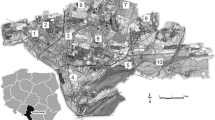Abstract
The air pollution of the city of Thessaloniki was studied, using park trees as biomonitors. The species analyzed were Ligustrum japonicum, Nerium oleander, Olea europea, Pinus brutia, Platanus orientalis, Populus alba, Populus nigra, and Robinia pseudoacacia. Acid digestion of leaf tissues and subsequent use of atomic absorption spectrometry was the analytical methodology used for the determination of heavy metals (Cu, Zn, and Pb). The concentration of heavy metals in the tree leaves depended on the metal species as well as on the position of the tree in the city. The mean concentrations of Cu ranged between 5 and 10 mg kg−1 dry weight, of Zn between 19 and 85 mg kg−1 DW and of Pb between <1.5 and 4.5 mg kg−1 DW. In some cases, the effect of road junctions proved more significant than the traffic load for the contamination of leaves. Some differentiation was also observed between tree species. Old leaves collected during the fall were more contaminated than young leaves collected during the spring. The roughness of the outer surface leaves contributed to the trapping and retention of air particles. The results were compared with corresponding results from lichens and mosses which were also collected for a similar study.
Similar content being viewed by others
References
Agarwala SC, Bisht SS, Sharma CP (1977) Relative effectiveness of certain heavy metals in producing toxicity and symptoms of iron deficiency in barley. Can J Bot 55:1299–1307
Balsberg-Pahlsson AM (1989) Effects of heavy-metal and SO2 pollution on the concentrations of carbohydrates and nitrogen in tree leaves. Can J Bot 67:2106–2113
Godzik S, Florkowski T, Piorek S, Sassen MMA (1979) An attempt to determine the tissue contamination of Quercus robur L. and Pinus sylvestris L. foliage by particulates from zinc and lead smelters. Environ Pollut 18:97–106
Grunhage L, Hager HJ (1982) Kombinatiotionswirkungen von SO2 und cadmium auf Pisum sativum L. 2. Enzyme, freie Aminosauren, organische Sauren und Zucker. Angew Bot 56:167–178
Hasemann G, Jung G, Wild A (1990) The loss of structural integrity in damaged spruce needles from locations exposed to air pollution. II. Epidermis and Stomata. J Phytopathol 128:33–45
Hollwarth M (1981) Physiologische Reaktionen in Pflanzen stadtischer Standorte unterschiedlicher Immissionsbelastung. Angew Bot 55:21–27
Kabata-Pendias A (1992) Trace elements in soils and plants, 2nd ed. CRC Press, Boca Raton, FL, 365 pp
Koziol MJ, Cowling DW (1980) Growth of ryegrass (Lolium perenne L.) exposed to SO2. III. Effects on free and storage carbohydrate concentrations. J Exp Bot 31:1687–1699
Livadas GC, Sahsamanoglou CS (1973) Wind in Thessaloniki Greece. Scientific Annals, Faculty of Physics and Mathematics, University of Thessaloniki 13:411–444
Malhotra SS, Sarkar SK (1979) Effects of sulphur dioxide on sugar and free amino acid content of pine seedlings. Physiol Plant 47:223–228
Martin MH, Coughtrey PJ (1982) Biological monitoring of heavy metal pollution. Land and air. Applied Science Publishers, London, New York, 475 pp
McLeod KW, Adriano DC, Boni AL, Corey JC, Horton JH, Paine D, Pinder JE (1980) Influence of a nuclear fuel chemical separators facility on the plutonium content of a wheat crop. J Environ Qual 9:306–315
Mudd JB, Kozlowski TT (1975) Responses of plants to air pollution. Physiol Ecol Ser. Academic Press, NY
Puchades R, Maquieira A, Planta M (1989) Rapid digestion procedure for the determination of lead in vegetable tissues by electrothermal atomisation atomic absorption spectrometry. Analyst 114:1397–1399
Rabinowitz MB (1972) Plant uptake of soil and atmospheric lead in Southern California. Chemosphere: 175–180
Sawidis T, Zachariadis G, Stratis J, Ladoukakis E (1993) Mosses as biological indicators for monitoring of heavy metal pollution. Fres Environ Bull 2:193–199
Smith MW, Brennan E (1984) Response of silver maple seedlings to an acute dose of root applied cadmium. For Sci 30:582–586
Ter Haar G (1970) Air as a source of lead in edible crops. Environ Sci Technol 4:226–229
Ure A, Mitchell G (1976) The determination of cadmium plant material and soil extracts by solvent extraction and atomic absorption with a carbon-rod atomiser. Anal Chim Acta 87:283–290
Wang D, Schaap W (1988) Air pollution impacts on plants: Current research challenges. ISI Atlas Sci, Anim Plant Sci 1(1):33–39
Author information
Authors and Affiliations
Rights and permissions
About this article
Cite this article
Sawidis, T., Marnasidis, A., Zachariadis, G. et al. A study of air pollution with heavy metals in Thessaloniki city (Greece) using trees as biological indicators. Arch. Environ. Contam. Toxicol. 28, 118–124 (1995). https://doi.org/10.1007/BF00213976
Received:
Revised:
Issue Date:
DOI: https://doi.org/10.1007/BF00213976




